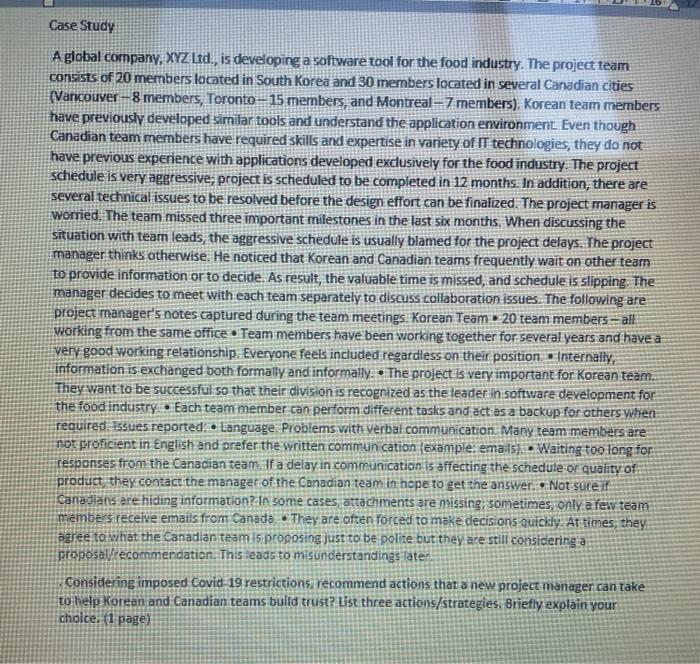Case Study A global company, XYZ Ltd., is developing a software tool for the food industry. The project team consists of 20 members located in South Korea and 30 members located in several Canadian cities (Vancouver -8 members, Toronto -15 members, and Montreal - 7 members). Korean team members have previously developed similar tools and understand the application environment Even though Canadian team members have required skills and expertise in variety of IT technologies, they do not have previous experience with applications developed exclusively for the food industry. The project schedule is very aggressive; project is scheduled to be completed in 12 months. In addition, there are several technical issues to be resolved before the design effort can be finalized. The project manager is worried. The team missed three important milestones in the last six months. When discussing the situation with team leads, the aggressive schedule is usually blamed for the project delays. The project manager thinks otherwise. He noticed that Korean and Canadian teams frequently wait on other team to provide information or to decide. As result, the valuable time is missed, and schedule is slipping. The manager decides to meet with each team separately to discuss collaboration issues. The following are project manager's notes captured during the team meetings Korean Team . 20 team members-all working from the same office Team members have been working together for several years and have a very good working relationship. Everyone feels included regardless on their position. Internally, information is exchanged both formally and informallyThe project is very important for Korean team. They want to be successful so that their division is recognized as the leader in software development for the food industry. Each team member can perform different tasks and act as a backup for others when required. Issues reported: Language. Problems with verbal communication. Many team members are not proficient in English and prefer the written communication (example, emails). - Waiting too long for responses from the Canadian team. If a delay in communication is affecting the schedule or quality of product they contact the manager of the Canadian team in hope to get the answer. Not sure if Canadians are hiding information? In some cases attachments are missing; sometimes, only a few team members receive emails from Canada . They are often forced to make decisions quickly. At times, they agree to what the Canadian team is proposing just to be polite but they are still considering a proposat cecommendation. This leads to misunderstandings rater Considering imposed Covid 19 restrictions, recommend actions that a new project manager can take to help Korean and Canadian teams build trust? List three actions/strategies. Briefly explain your choice. (1 page) Case Study A global company, XYZ Ltd., is developing a software tool for the food industry. The project team consists of 20 members located in South Korea and 30 members located in several Canadian cities (Vancouver -8 members, Toronto -15 members, and Montreal - 7 members). Korean team members have previously developed similar tools and understand the application environment Even though Canadian team members have required skills and expertise in variety of IT technologies, they do not have previous experience with applications developed exclusively for the food industry. The project schedule is very aggressive; project is scheduled to be completed in 12 months. In addition, there are several technical issues to be resolved before the design effort can be finalized. The project manager is worried. The team missed three important milestones in the last six months. When discussing the situation with team leads, the aggressive schedule is usually blamed for the project delays. The project manager thinks otherwise. He noticed that Korean and Canadian teams frequently wait on other team to provide information or to decide. As result, the valuable time is missed, and schedule is slipping. The manager decides to meet with each team separately to discuss collaboration issues. The following are project manager's notes captured during the team meetings Korean Team . 20 team members-all working from the same office Team members have been working together for several years and have a very good working relationship. Everyone feels included regardless on their position. Internally, information is exchanged both formally and informallyThe project is very important for Korean team. They want to be successful so that their division is recognized as the leader in software development for the food industry. Each team member can perform different tasks and act as a backup for others when required. Issues reported: Language. Problems with verbal communication. Many team members are not proficient in English and prefer the written communication (example, emails). - Waiting too long for responses from the Canadian team. If a delay in communication is affecting the schedule or quality of product they contact the manager of the Canadian team in hope to get the answer. Not sure if Canadians are hiding information? In some cases attachments are missing; sometimes, only a few team members receive emails from Canada . They are often forced to make decisions quickly. At times, they agree to what the Canadian team is proposing just to be polite but they are still considering a proposat cecommendation. This leads to misunderstandings rater Considering imposed Covid 19 restrictions, recommend actions that a new project manager can take to help Korean and Canadian teams build trust? List three actions/strategies. Briefly explain your choice. (1 page)







